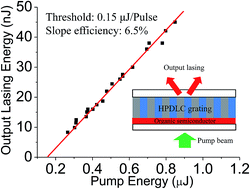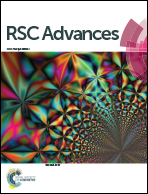Efficient laser emission from organic semiconductor activated holographic polymer dispersed liquid crystal transmission gratings
Abstract
Performances of organic distributed feedback (DFB) lasers made from holographic polymer dispersed liquid crystal (HPDLC) transmission gratings were greatly improved by replacing common laser dye with organic semiconductor poly(2-methoxy-5-(2′-ethyl-hexyloxy)-p-phenylenevinylene) (MEH-PPV) as the gain medium. The MEH-PPV layer was laminated between the glass substrate and the HPDLC grating layer. Light interaction for feedback is provided by an evanescent wave spread into the grating layer. The device showed single-mode, TE polarized laser emission with a threshold of only 0.17 μJ per pulse (17 μJ cm−2). Slope efficiencies as high as 4.7% and 6.5% were measured for optical pumping of the device with P polarization and S polarization, respectively. Lasing was also coupled by the grating out of the waveguide and into free space. Furthermore, the output laser wavelength was systematically tuned over a range of 43 nm by varying the grating period. The laser thresholds at different wavelengths trace well with the amplified spontaneous emission spectrum of the MEH-PPV film. In terms of the HPDLC technique, our results show there is still plenty of potential to be exploited for fabricating organic DFB lasers.


 Please wait while we load your content...
Please wait while we load your content...